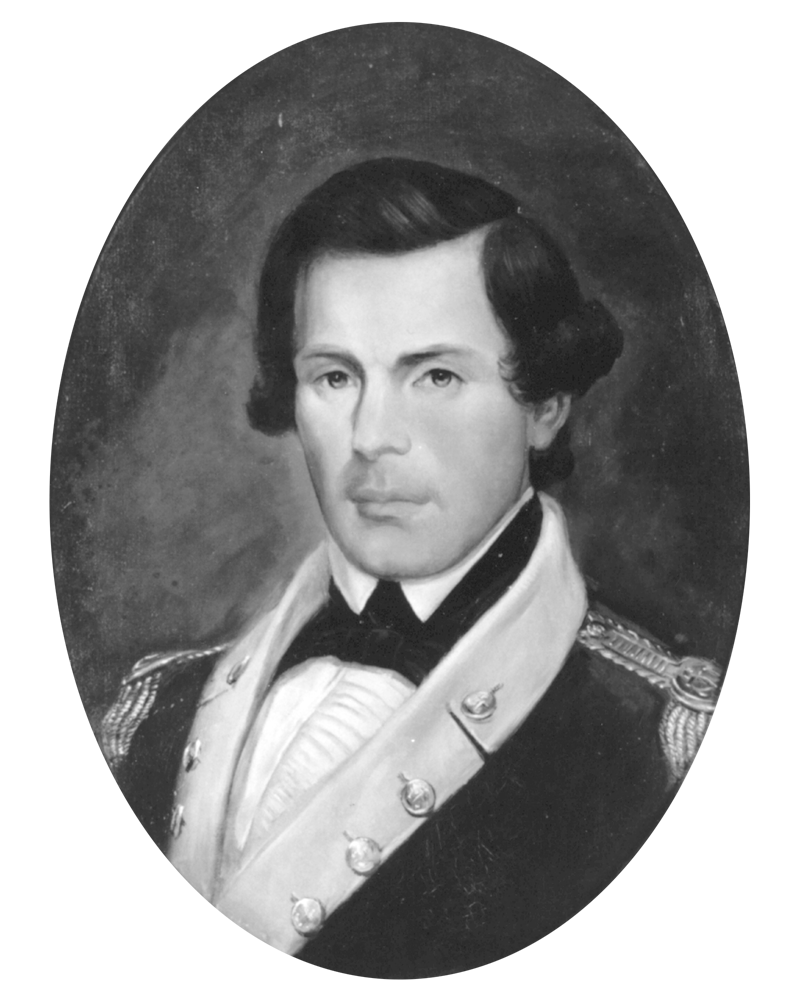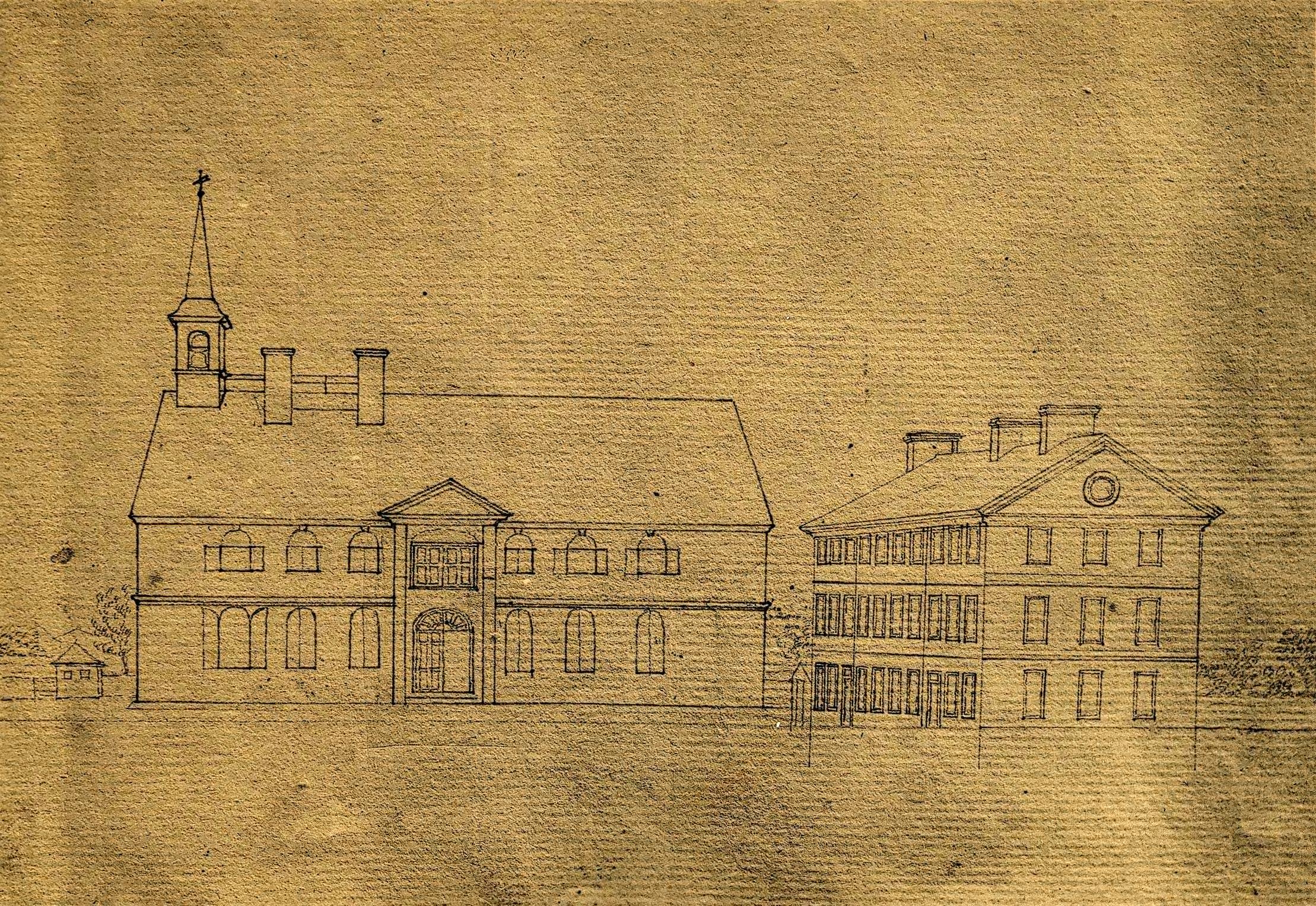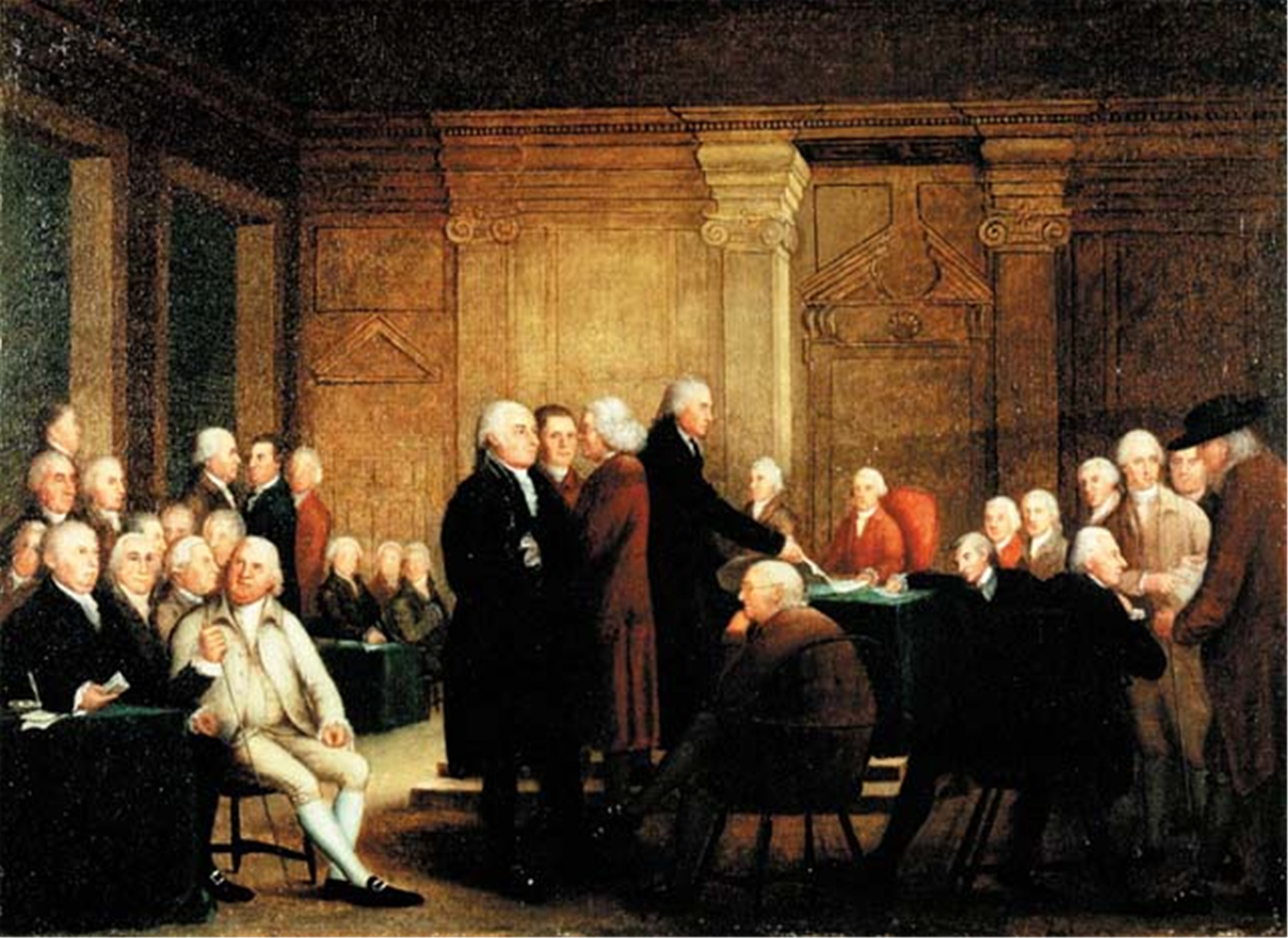|
Samuel Nicholas
Samuel Nicholas (1744 – August 27, 1790) was an American Marine and military officer who was the first officer commissioned in the United States Continental Marines (predecessor to the United States Marine Corps) and by tradition is considered to be the first Commandant of the Marine Corps. Early life Nicholas was born in Philadelphia, Pennsylvania, in 1744, the youngest of three, to Anthony and Mary (Shute Cowman) Nicholas. His father was a blacksmith, un-Friended by the Philadelphia Meeting in 1749 for "Evil Conduct in frequent drinking strong Liquor to Excess," and died when Samuel was 7. His mother, Mary Shute Nicholas, had died the year before. He was then taken in by his uncle, Attwood Shute, the Mayor of Philadelphia (1756–1758). In January 1752, his uncle enrolled him at the Academy and College of Philadelphia (now the University of Pennsylvania), the secondary-school counterpart of the College. Nicholas was a student there until the end of 175While at school, ... [...More Info...] [...Related Items...] OR: [Wikipedia] [Google] [Baidu] |
Philadelphia
Philadelphia ( ), colloquially referred to as Philly, is the List of municipalities in Pennsylvania, most populous city in the U.S. state of Pennsylvania and the List of United States cities by population, sixth-most populous city in the United States, with a population of 1,603,797 in the 2020 United States census, 2020 census. The city is the urban core of the Philadelphia metropolitan area (sometimes called the Delaware Valley), the nation's Metropolitan statistical area, seventh-largest metropolitan area and ninth-largest combined statistical area with 6.245 million residents and 7.379 million residents, respectively. Philadelphia was founded in 1682 by William Penn, an English Americans, English Quakers, Quaker and advocate of Freedom of religion, religious freedom, and served as the capital of the Colonial history of the United States, colonial era Province of Pennsylvania. It then played a historic and vital role during the American Revolution and American Revolutionary ... [...More Info...] [...Related Items...] OR: [Wikipedia] [Google] [Baidu] |
College Of Philadelphia
The Academy and College of Philadelphia (1749–1791) was a boys' school and men's college in Philadelphia in the colonial-era Province of Pennsylvania. Founded in 1749 by a group of local notables that included Benjamin Franklin, the Academy of Philadelphia began as a private secondary school, occupying a former religious school building at the southwest corner of 4th and Arch Streets. The academy taught reading, writing, and arithmetic to both paying and charity students. The College of Philadelphia was founded in 1755, when the academy's charter was amended to allow the granting of advanced academic degrees. The Medical School of the College of Philadelphia, founded in 1765, was the first medical school in North America. In 1791, the College of Philadelphia merged with the University of the State of Pennsylvania, to form the present-day University of Pennsylvania. History Benjamin Franklin was the first president of the board of trustees and authored the constitution for the a ... [...More Info...] [...Related Items...] OR: [Wikipedia] [Google] [Baidu] |
Bahamas
The Bahamas, officially the Commonwealth of The Bahamas, is an archipelagic and island country within the Lucayan Archipelago of the Atlantic Ocean. It contains 97 per cent of the archipelago's land area and 88 per cent of its population. It comprises more than 3,000 islands, cays and islets in the Atlantic Ocean, and is located north of Cuba and north-west of the island of Hispaniola (split between the Dominican Republic and Haiti) and the Turks and Caicos Islands, southeast of the U.S. state of Florida and east of the Florida Keys. The capital and largest city is Nassau on the island of New Providence. The Royal Bahamas Defence Force describes the Bahamas' territory as encompassing of ocean space. The Bahama islands were inhabited by the Arawak and Lucayans, a branch of the Arawakan- speaking Taíno, for many centuries. Christopher Columbus was the first European to see the islands, making his first landfall in the "New World" in 1492 when he landed on the ... [...More Info...] [...Related Items...] OR: [Wikipedia] [Google] [Baidu] |
New Providence
New Providence is the most populous island in The Bahamas, containing more than 70% of the total population. On the eastern side of the island is the national capital, national capital city of Nassau, Bahamas, Nassau; it had a population of 246,329 at the 2010 Census, and a population of 292,522 at the 2022 census. Nearly three quarters of The Bahamas's population lives in New Providence. The island was originally under Spanish control following Christopher Columbus's purported discovery of the New World, but the Spanish government showed little interest in developing the island (and The Bahamas as a whole). Nassau, the island's largest city, was formerly known as Charles-town, but it was burned to the ground by the Spanish in 1684. It was laid out and renamed Nassau in 1695 by Nicholas Trott, the most successful Lords Proprietor, Lord Proprietor, in honour of the House of Orange-Nassau, Prince of Orange-Nassau who became William III of England. The three branches of Politics ... [...More Info...] [...Related Items...] OR: [Wikipedia] [Google] [Baidu] |
Virginia
Virginia, officially the Commonwealth of Virginia, is a U.S. state, state in the Southeastern United States, Southeastern and Mid-Atlantic (United States), Mid-Atlantic regions of the United States between the East Coast of the United States, Atlantic Coast and the Appalachian Mountains. The state's List of capitals in the United States, capital is Richmond, Virginia, Richmond and its most populous city is Virginia Beach, Virginia, Virginia Beach. Its most populous subdivision is Fairfax County, Virginia, Fairfax County, part of Northern Virginia, where slightly over a third of Virginia's population of more than 8.8million live. Eastern Virginia is part of the Atlantic Plain, and the Middle Peninsula forms the mouth of the Chesapeake Bay. Central Virginia lies predominantly in the Piedmont (United States), Piedmont, the foothill region of the Blue Ridge Mountains, which cross the western and southwestern parts of the state. The fertile Shenandoah Valley fosters the state's mo ... [...More Info...] [...Related Items...] OR: [Wikipedia] [Google] [Baidu] |
John Murray, 4th Earl Of Dunmore
John Murray, 4th Earl of Dunmore (1730 – 25 February 1809) was a British colonial administrator who served as the List of colonial governors of Virginia, governor of Virginia from 1771 to 1775. Dunmore was named List of colonial governors of New York, governor of New York in 1770. He succeeded to the same position in the colony of Virginia the following year after the death of Norborne Berkeley, 4th Baron Botetourt. As Virginia's governor, Dunmore directed a series of campaigns against the trans-Appalachian Native Americans in the United States, Indians, known as Lord Dunmore's War. He is noted for issuing a 1775 document, Dunmore's Proclamation, offering freedom to Slavery in the colonial history of the United States, slaves who fought for the British Crown against Patriot (American Revolution), Patriot rebels in Virginia. Dunmore fled to New York after the burning of Norfolk in 1776 and later returned to Britain. He was List of governors of the Bahamas, Governor of the Baha ... [...More Info...] [...Related Items...] OR: [Wikipedia] [Google] [Baidu] |
Esek Hopkins
Commodore (rank), Commodore Esek Hopkins (April 26, 1718February 26, 1802) was a Continental Navy officer and privateer. He served as the only commander-in-chief of the Continental navy during the American Revolutionary War, when the Continental Congress appointed him to the position in December 1775. Hopkins is known for carrying out the successful raid of Nassau in the Bahamas, which captured large amounts of military supplies. His legacy today has become controversial due to Hopkins' involvement in the Atlantic slave trade and for torturing British prisoners of war. Early life and career Esek Hopkins was born in Scituate, Rhode Island, Scituate, in the Colony of Rhode Island and Providence Plantations, into one of the most prominent families of what is today's Rhode Island. At the age of twenty he went to sea and rapidly came to the fore as a good sailor and skillful trader. Before the American Revolutionary War, Revolutionary War he had sailed to nearly every quarter of the Ea ... [...More Info...] [...Related Items...] OR: [Wikipedia] [Google] [Baidu] |
USS Alfred (1774)
''Alfred'' was the merchant vessel ''Black Prince'', named for Edward the Black Prince and launched in 1774. The Continental Navy acquired her in 1775, renaming her ''Alfred'' after 9th century English monarch Alfred the Great, and commissioned her as a 24-gun frigate. During the American Revolutionary War, the ''Alfred'' participated in two major naval operations; the battles of Nassau and Block Island. The Royal Navy captured her in 1778, took her into service as HMS ''Alfred'', and sold her in 1782. She then became the merchantman ''Alfred'', and sailed between London and Jamaica. ''Black Prince'' ''Black Prince'' was built at Philadelphia, Pennsylvania in 1774. No record of her builder seems to have survived, but it is possible that John Wharton may have constructed the ship. She was owned by Willing, Morris & Co., a merchant trading firm operated by Thomas Willing and Robert Morris. John Barry served as the ship's only master during her career as a Philadelphia merchantm ... [...More Info...] [...Related Items...] OR: [Wikipedia] [Google] [Baidu] |
Marine Detachment
A Marine Detachment, or MarDet, was a unit of United States Marines permanently embarked on large warships including cruisers, battleships, and aircraft carriers, typically consisting of anywhere 35 and 85 men. They were a regular component of a ship's company from the formation of the United States Marine Corps until 1998. Missions of shipboard Marine Detachments evolved, and included protecting the ship's captain, security and defense of the ship, operating the brig, limited action ashore, securing nuclear weapons and ceremonial details. The Marines' successful command structure for dispersed detachments aboard warships encouraged detachments for other purposes. History of shipboard Marine detachments The Continental Congress established a Marine Corps of two battalions on 10 November 1775. Marines were detached from these battalions to serve aboard individual warships. Although these battalions were temporarily disbanded following the American Revolutionary War, the United ... [...More Info...] [...Related Items...] OR: [Wikipedia] [Google] [Baidu] |
Continental Navy
The Continental Navy was the navy of the United Colonies and United States from 1775 to 1785. It was founded on October 13, 1775 by the Continental Congress to fight against British forces and their allies as part of the American Revolutionary War. Due to the efforts of several prominent patrons such as John Adams, the Continental Navy eventually developed into a substantial force, though it never replicated the successes of the Continental Army. In 1776, Commodore (United States), Commodore Esek Hopkins was appointed by Congress to command the navy. Initially, the Continental Navy's ships consisted of purchased merchantmen, due to a lack of funds for constructing purpose-built warships. This resulted from American leaders focusing on the Continental Army, as they were aware that the Royal Navy's command of the sea meant no naval force they raised could hope to seriously challenge it. The primary missions of the Continental Navy, which eventually acquired a series of frigates an ... [...More Info...] [...Related Items...] OR: [Wikipedia] [Google] [Baidu] |
Second Continental Congress
The Second Continental Congress (1775–1781) was the meetings of delegates from the Thirteen Colonies that united in support of the American Revolution and American Revolutionary War, Revolutionary War, which established American independence from the British Empire. The Congress constituted a new federation that it first named the United Colonies of North America, and in 1776, renamed the United States, United States of America. The Congress began convening in present-day Independence Hall in Philadelphia, on May 10, 1775, with representatives from 12 of the 13 colonies, following the Battles of Lexington and Concord, the first battles of the Revolutionary War, which were fought on April 19, 1775. The Second Continental Congress succeeded the First Continental Congress, which met from September 5 to October 26, 1774, also in Philadelphia. The Second Congress functioned as the ''de facto'' federation government at the outset of the Revolutionary War by raising militias, direc ... [...More Info...] [...Related Items...] OR: [Wikipedia] [Google] [Baidu] |
Samuel Nicholas
Samuel Nicholas (1744 – August 27, 1790) was an American Marine and military officer who was the first officer commissioned in the United States Continental Marines (predecessor to the United States Marine Corps) and by tradition is considered to be the first Commandant of the Marine Corps. Early life Nicholas was born in Philadelphia, Pennsylvania, in 1744, the youngest of three, to Anthony and Mary (Shute Cowman) Nicholas. His father was a blacksmith, un-Friended by the Philadelphia Meeting in 1749 for "Evil Conduct in frequent drinking strong Liquor to Excess," and died when Samuel was 7. His mother, Mary Shute Nicholas, had died the year before. He was then taken in by his uncle, Attwood Shute, the Mayor of Philadelphia (1756–1758). In January 1752, his uncle enrolled him at the Academy and College of Philadelphia (now the University of Pennsylvania), the secondary-school counterpart of the College. Nicholas was a student there until the end of 175While at school, ... [...More Info...] [...Related Items...] OR: [Wikipedia] [Google] [Baidu] |








